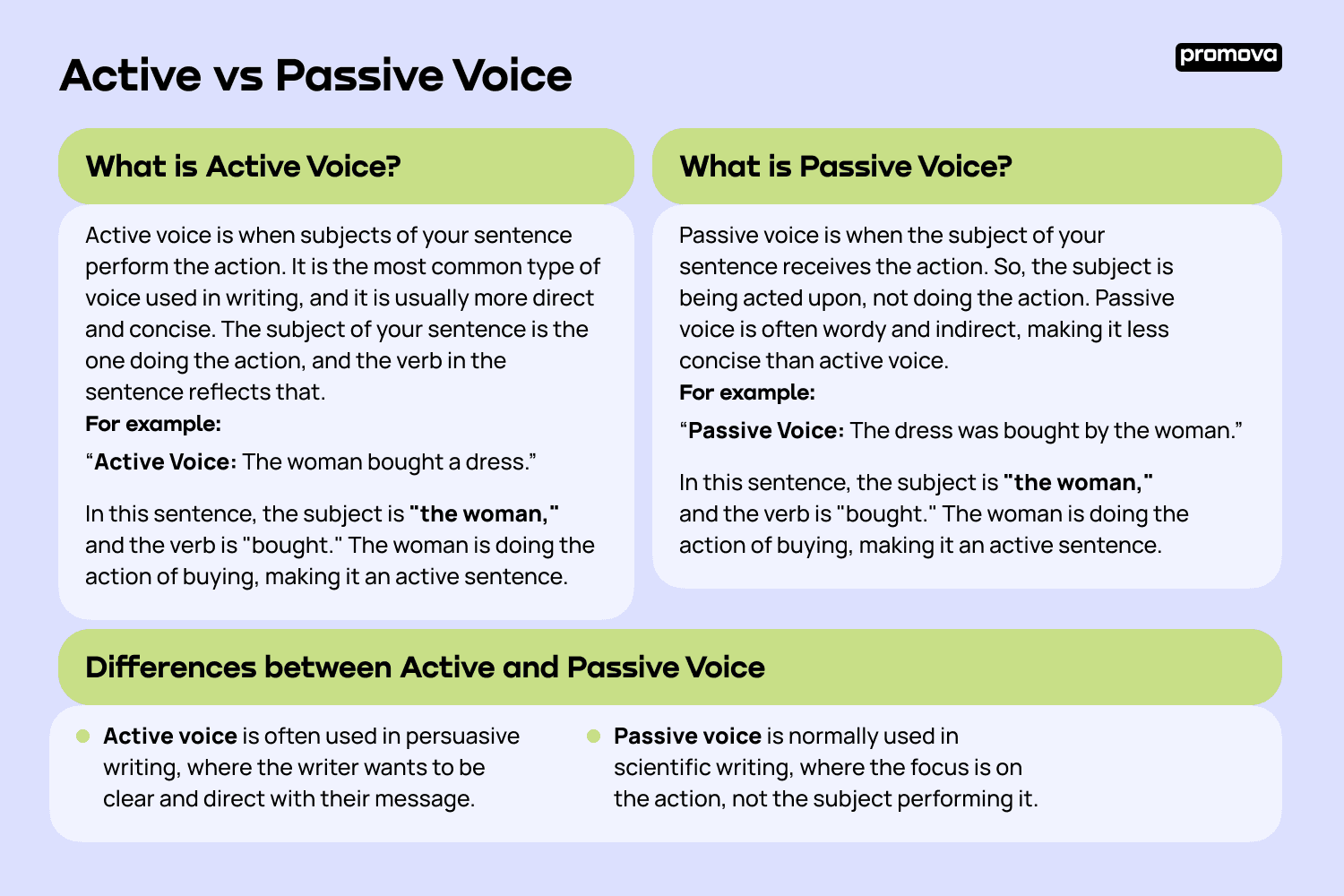Active vs Passive Voice
Contents
Understanding active and passive voice can make a significant impact on your writing. In this reference, we will explore the differences between active and passive voice, advantages of using each, and examples of both. By the end of this reference, you will know when and how to use active vs passive voice in your writing.
What is Active Voice?
Active voice is when subjects of your sentence perform the action. It is the most common type of voice used in writing, and it is usually more direct and concise. The subject of your sentence is the one doing the action, and the verb in the sentence reflects that. For example:
Active Voice: The woman bought a dress.
In this sentence, the subject is "the woman," and the verb is "bought." The woman is doing the action of buying, making it an active sentence.
What is Passive Voice?
Passive voice is when the subject of your sentence receives the action. So, the subject is being acted upon, not doing the action. Passive voice is often wordy and indirect, making it less concise than active voice. For example:
Passive Voice: The dress was bought by the woman.
In this sentence, the subject is "the woman," and the verb is "was bought." The dress is being bought by the woman, making it a passive sentence.
Differences between Active and Passive Voice
In active voice, the subject performs the action, while in passive voice, your subject is the one that receives it. Active voice is usually more direct and concise, while passive voice is wordy and indirect.
Active voice is often used in persuasive writing, where the writer wants to be clear and direct with their message.
Passive voice is normally used in scientific writing, where the focus is on the action, not the subject performing it.
Advantages of Using Active Voice
There are several advantages to using active voice in your writing.
- It's often more engaging and easier to understand for readers. It allows the writer to be more direct and concise, making the message clearer.
- It's more persuasive, making it an excellent choice for marketing and advertising.
- It's often more enjoyable to read, as it creates a sense of movement and action in the writing.
- Using active voice can also help you avoid ambiguity and confusion in your writing.
2
Advantages of Using Passive Voice
While passive voice is often seen as less desirable in writing, there are still some advantages to using it.
- Passive voice can be useful when the subject is unknown or unimportant.
- It can be helpful in situations where the writer wants to avoid placing blame or responsibility on a specific person or group.
- It's useful in scientific writing or technical manuals, where the focus is on the action, not the person performing it. In these cases, passive voice can be more precise and accurate.
Examples of Active and Passive Voice
There are many active and passive voice examples that can help better understand the difference.
- Active Voice: The man cooked the meat.
- Passive Voice: The meat was cooked by the man.
In the active voice example, the subject (the chef) performs the action (cooking the meal). In the passive voice example, the subject (the meal) receives the action (being cooked by the chef).
- Active Voice: The student aced the test.
- Passive Voice: The test was aced by the student.
In the active voice example, the subject (the student) performs the action (acing the test). In the passive voice example, the subject (the test) receives the action (being aced by the student).

Summary
Active and passive voice are two essential concepts in writing. Active voice is when your subject performs the action, while passive voice is when your subject receives the action. Active voice is often more direct and concise, while passive voice is wordy and indirect. Understanding when to use passive vs active voice can make a significant difference in your writing.
Next time you sit down to write, think about the message you want to deliver and choose the voice that best suits your purpose. By doing so, you will create more effective and engaging writing that resonates with your readers!
Comments